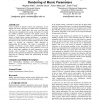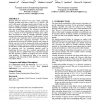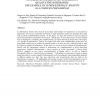697 search results - page 17 / 140 » Symbols are not uniquely human |
105
Voted
IUI
2004
ACM
15 years 5 months ago
2004
ACM
Analysis of sketched digital ink is often aided by the division of stroke points into perceptually-salient fragments based on geometric features. Fragmentation has many applicatio...
118
click to vote
ICMI
2005
Springer
15 years 5 months ago
2005
Springer
Current methods of playlist creation and maintenance do not support user needs, especially in a mobile context. Furthermore, they do not scale: studies show that users with large ...
111
Voted
BMCBI
2007
15 years 15 days ago
2007
Background: In recent years, mammalian protein-protein interaction network databases have been developed. The interactions in these databases are either extracted manually from lo...
107
Voted
KDD
2004
ACM
16 years 24 days ago
2004
ACM
Moments before the launch of every space vehicle, engineering discipline specialists must make a critical go/no-go decision. The cost of a false positive, allowing a launch in spi...
ECIS
2004
15 years 1 months ago
2004
As Information Systems (IS) research increasingly acknowledges the importance of non-positivist approaches, the case for a plurality of theories to guide qualitative studies has g...



